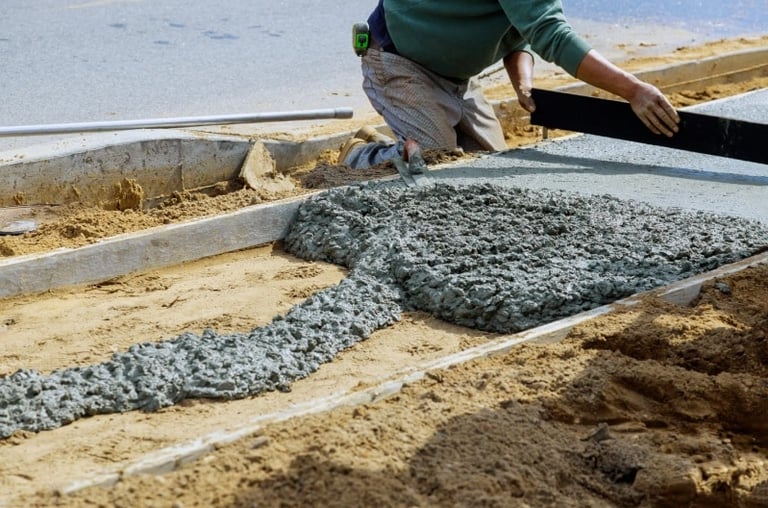CALL US TODAY! → (863) 348-2601 / (863) 257-1120
The Value of Concrete Sidewalks in Urban and Residential Settings
From homes to public spaces—sidewalks built to last and protect.
7/26/20254 min read


The Importance of ADA Compliance in Sidewalk Design
The Americans with Disabilities Act (ADA) establishes essential guidelines for sidewalk design to ensure accessibility for individuals with disabilities. These standards encompass various elements including width, slope, surface texture, and edge design, all of which play a critical role in making sidewalks navigable for everyone. Compliance with ADA specifications promotes inclusivity in urban and residential environments, facilitating mobility for individuals with different abilities.
First, width is a fundamental factor in sidewalk design. The ADA requires sidewalks to be at least 36 inches wide to accommodate wheelchair users and others who may require additional space for safe passage. This standard not only helps with mobility but also reduces the risk of accidents that may occur when pedestrians are forced to navigate narrow pathways. Furthermore, the inclusion of designated passing zones can further enhance safety on busier sidewalks.
Slope is another critical aspect outlined by the ADAs guidelines. Sidewalks must maintain a maximum slope of 1:20, ensuring that individuals using wheelchairs can safely navigate inclines without undue strain. Improper slope can lead to safety hazards, including the risk of tipping over or losing control. Surface texture also plays an important role; sidewalks should boast a slip-resistant finish that can accommodate various weather conditions, thus ensuring the safety of all users, including those with visual impairments.
Edge design is equally significant for curb ramps and transitions, which should be smooth and free from obstacles. All of these requirements highlight the legal implications of non-compliance. Failure to adhere to ADA standards could result in legal repercussions and financial liabilities for municipalities and property owners. Moreover, creating an inclusive environment indicates commitment to social responsibility and fosters a sense of community. Thus, prioritizing ADA compliance in sidewalk design is not only a legal mandate but also a moral obligation to ensure equal access for all individuals.
Durability and Maintenance of Concrete Sidewalks
Concrete sidewalks are renowned for their durability, making them an excellent choice for both urban and residential environments. One of the standout features of concrete is its ability to withstand various weather conditions, from torrential rain to extreme heat. Unlike materials such as asphalt or wood, concrete demonstrates superior resilience to moisture and temperature fluctuations, thereby reducing the likelihood of damage. This inherent strength permits concrete sidewalks to handle heavy foot traffic without significant wear, resulting in a longer lifespan compared to other materials.
In addition to weather resistance, concrete is less prone to common issues such as warping or rotting that can plague alternative sidewalk materials. With proper installation, concrete can achieve a lifespan exceeding 30 years, significantly outpacing materials like asphalt, which typically requires replacement or resurfacing within 15 years. Nevertheless, over time, surface wear, cracks, and other imperfections can develop, influenced by factors such as the quality of installation, seasonal changes, and even the weight of loads traversing the surface.
To mitigate these issues and extend the lifespan of concrete sidewalks, regular maintenance is essential. Homeowners and urban planners should consider implementing several preventative measures. First, periodic cleaning not only enhances aesthetic appeal but also removes debris that could trap moisture against the sidewalk surface. Additionally, applying a sealant can protect the concrete from water infiltration, freeze-thaw cycles, and stains. Cracks, however small, should be addressed promptly using a concrete filler to prevent them from expanding. Lastly, it is advisable to monitor for signs of settling or shifting, as these can indicate underlying issues that may need professional assessment.
Aesthetic Appeal of Concrete Sidewalks
Concrete sidewalks hold significant aesthetic value in both urban and residential environments. The design options available for concrete sidewalks allow homeowners and city planners to create visually appealing pathways that enhance the overall charm of the landscape. The flexibility of concrete as a material enables it to take on various colors, styles, and textures, offering a plethora of customization possibilities.
One popular method of enhancing the visual appeal of concrete is through decorative techniques such as stamping and staining. Stamped concrete can mimic the appearance of natural materials like stone or brick, adding depth and character to sidewalks. This technique creates intricate patterns that can complement the surrounding architecture or landscape, thereby elevating the aesthetic experience in any neighborhood. Staining offers another approach, providing sidewalks with vibrant colors or subtle hues that can harmonize with existing design elements. Whether opting for a simple, clean look or a more elaborate decorative pattern, the choices available ensure that concrete sidewalks can align with diverse aesthetic preferences.
The impact of well-designed concrete sidewalks on property value should not be overlooked. Attractive sidewalks increase curb appeal, often making properties more desirable to potential buyers. A neat and inviting walkway communicates a sense of care and attention to detail that invites residents and visitors alike. Additionally, aesthetically pleasing sidewalks contribute to neighborhood charm, fostering a sense of community and pride. When public spaces are designed with beauty in mind, they become more than mere thoroughfares; they transform into enjoyable environments that enhance the quality of life for residents.
Incorporating well-designed concrete sidewalks not only improves aesthetics but also plays a pivotal role in creating harmonious and inviting urban and residential landscapes.
Safety and Property Layout: Enhancing Community Spaces
Concrete sidewalks serve as vital components in urban and residential landscapes, directly contributing to the safety and well-being of community members. By providing clear and defined pathways for pedestrians, these sidewalks significantly reduce the likelihood of accidents, particularly in high-traffic areas. The physical separation between vehicle pathways and pedestrian zones creates a safer environment, promoting walking as a viable mode of transportation.
Moreover, the integration of concrete sidewalks into property layouts enhances the accessibility of community spaces. Well-designed sidewalks facilitate easy movement to various access points, such as parks, shops, and public transport, ultimately encouraging residents to engage in outdoor activities. The presence of sidewalks can also help to unify various elements of urban design, including landscaping features and recreational areas, thereby fostering a sense of community and promoting social interaction.
When planning the installation of concrete sidewalks, several practical tips can maximize their safety and effectiveness. It is essential to consider the width of the sidewalks to accommodate foot traffic comfortably. A width of at least five feet is recommended for a two-way pedestrian path, allowing ample space for individuals, families, and those using mobility aids to navigate effortlessly.
Additionally, adequate lighting along sidewalks improves visibility during nighttime, thus enhancing safety. The incorporation of tactile paving or clear signage can help those with visual impairments navigate the sidewalk network more confidently. Investing in durable materials, such as high-quality concrete, ensures the longevity of these pathways while minimizing maintenance needs over time.
In conclusion, concrete sidewalks play a crucial role in enhancing safety and accessibility within urban and residential settings. By thoughtfully integrating these pathways into community designs, we can foster more walkable neighborhoods, ultimately contributing to healthier lifestyles and vibrant public spaces.
Follow Us On Social Media
Contacts
Subscribe To Our Newsletter
Copyright © 2025 Los Brothers 1 Corp – "2 Brothers. 1 Strong Foundation!"
Fernando: (863) 348-2601
Rodrigo: (863) 257-1120
Hours
24/7 – We’re available day and night for your concrete needs.


